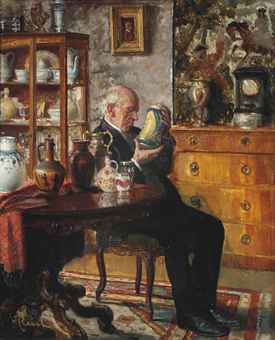 |
| Adolf Reich The Connoisseur Picture: Christie's |
Bendor Grosvenor has written about his recent experience at a panel on connoisseurship hosted by the Yale Centre for British Art. It's worth watching; he makes a rousing and comprehensive case for the value of connoisseurship. But he is too polite about the response by Tate Britain's Martin Myrone.
Myrone thinks that his critique of connoisseurship carries weight because as a curator of a national museum he acts on behalf of visitors, whereas dealers like Grosvenor are tainted by self-interest. It's a textbook example of the ad hominum fallacy, assuming that the truth of a statement can be established by the position of the speaker. Even if we assume Grosvenor to be utterly corrupt, his arguments stand or fall on their own terms because none of his claims about connoisseurship rested on his own authority. His case was made in universalisable and disinterested terms, self-consciously avoiding examples of his own connoisseurship.
It was Myrone's argument that invoked the authority of position. He claimed that as a civil servant he is imbued with a higher calling, and that he is a representative of the people. He is not making an argument that we can engage with, but rather demanding that we defer to his authority. That authority, which he exercises in our name, was not gained by popular vote, but because he managed to secure an immensely sought-after job in a competitive and politicised field. The language of his subsequent article in The Art Newspaper is telling, stating that 'numerous studies' back up his position, but citing none, and emphasising at every turn the difference between commercial interest and public interest (not always a contradiction).
In truth dealers have very little authority, because everyone knows they are trying to sell you something. A dealer claiming that a picture they own is by Van Dyck carries very little weight. They must convince recognised experts to back their claims. Of course there have been famous examples of outright corruption, of experts selling certificates of authenticity, but that is not the norm. Dealers have to work harder to maintain their reputations precisely because their motives are doubted. Unlike the tenured Dr Myrone, dealers must struggle constantly to maintain their reputations. Art dealing will inevitably attract connoisseurs with a more expansive view of authorship. Sceptical scholars with more parsimonious views will not do well ("some think this is a Rembrandt, but I'm not so sure" isn't a great sales pitch). That doesn't mean that dealers are inherently dishonest or acting in bad faith.
More engaged connoisseurship from academia and museums would provide a stronger counterweight (I am well aware that there is already much excellent connoisseurship in museums and universities; I'm just calling for more of it). It sometimes seems to me that the locus of connoisseurship is too much focused on the market. Some artists are radically contested between extreme contrasting views of their output, particularly in the world of old master drawings. Some scholars think there are twice as many extant drawings by major artists like Rembrandt and Titian than others. But guess which ones get consulted by dealers and auctioneers!
There is often only one scholar regarded as authoritative on a particular artist, which means that only one view of that artist becomes canonical. And one venerable expert in early Italian painting is regularly quoted in auction catalogues because he is so willing to attribute pictures to major artists. I'm not suggesting anything untoward, but inevitably it is the experts with the expansive views that are endorsed by the art market. The fault is not with dealers and auctioneers; I believe they generally act with good faith. The fault rather is that connoisseurial debates in universities and museums are too quiescent and too focused on major artists and famous pictures.
Myrone is right that arguments about connoisseurship are related to claims to cultural authority, but it is trivial. All of us engaging in debate are trying to win others over and to assert our own voices, even if we work at an august institution like Tate Britain. Let us accept that participants in the debate will have their own interests and agendas, and argue about the substance. Myrone's inept and arrogant argument has set the debate backwards, but I share his scepticism about connoisseurial certainty and I think we should be more tolerant of ambiguity. There is much more to be said in the debate about connoisseurship, but we need to set aside claims to institutional authority if we are to engage in debate at all.
The original debate is well worth watching, and I thought the starting positions at the Yale seminar were better than the subsequent articles. ArtWatch has also provided a useful account, here.
Yes, Bendor was too kind to the dreadful Myrone. Underlying the argument is the fashion to abandon treating art as art and to talk instead about social relevance. Of course it is not wholly wrong to be concerned about the public response, about the political subtexts and so, and connoisseurship can be narrow. But Myrone taking the moral high ground is ridiculous. Many curators are high minded, but some are also prone to self-deception and also ready to deceive the public when the public interferes with their autonomy. I am rereading the autobiography of K Clark, who contrasts the attitudes of Berenson and Fry, who apparently hated each other. In fact nearly everyone in 1930s in the art world, according to K, hated each other!
ReplyDeleteThanks, and I completely agree. I'm reminded of Henry Kissinger's comment after joining Harvard's faculty after a stint as Secretary of State, "the rows in academia are more bitter because the stakes are smaller".
Delete